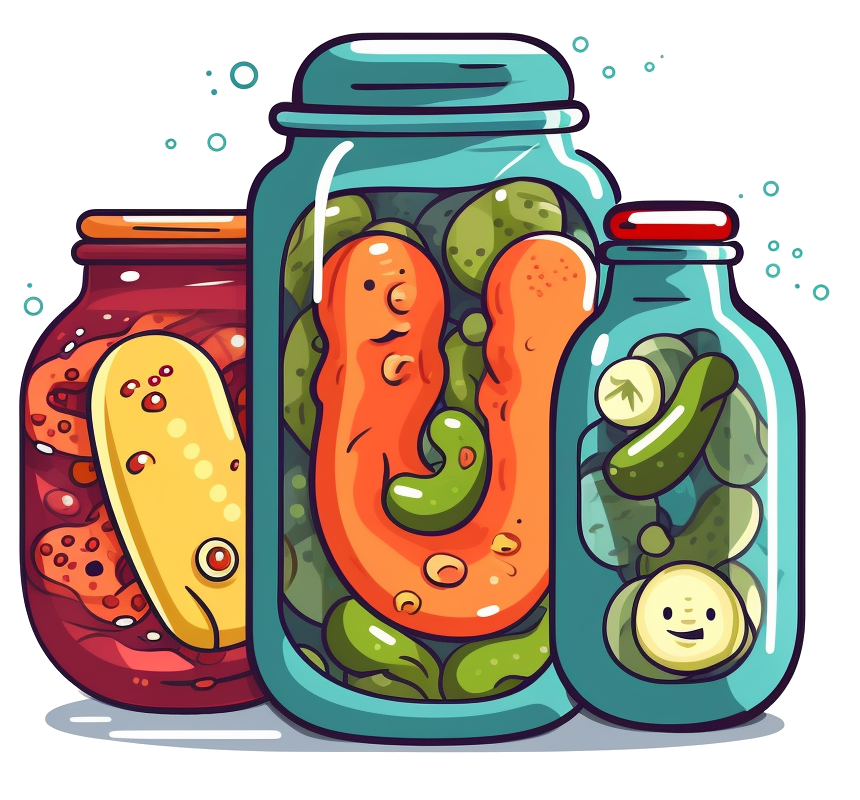I’m thinking mostly of turşu (torshi) and kimchi.
Traditionally, these vegetables are able to ferment fully sealed for weeks, months, or even years. My family ferments turşu for 6 weeks and they fill that bottle to the brim with no problem. But I have seen many reports of people doing European style fermentation who have popped lids and made a mess because they didn’t “burp” the jar.
So what is the difference that makes them not need to release pressure? Can they be made in a metal lid mason jar?
Also, there is vinegar in turşu solution - anywhere from 10% to 50% volume depending on the recipe. Some recipes boil the solution before adding to the jar. I have read many people say both vinegar and boiling will kill your culture, but I have seen both done and they definitely work. Any insights on this?


If you don’t fully seal the jar you don’t need to burp it. You can use any of the following:
Vinegar will inhibit many microorganisms, but the ones you care about the most when it comes to wild fermentation (lactobacillus, yeast, and acetobacter) should be ok at low concentrations - keep in mind 2 of these produce their own acid so they have a fairly high acid tolerance - yeast works at a pH of 4-6 though - a 50% vinegar solution is 2.5% acetic acid, which has a pH of ~3 which means it is 10x too acidic for yeast to function
Anything you boil will have all the microorganisms killed off - keep in mind pickling and fermentation are different - recipes that require fermentation will have you cool the vinegar solution before covering the vegetables and that flavor will continue to develop the longer you leave it. Recipes with heavy vinegar content added while still hot to the vegetables are pickle recipes - the flavors will meld over the first couple days but after a week or two, that is when the flavor development will stop - these are the going to be the recipes that don’t explicitly tell you to burp the jar, store uncovered, etc.
Thank you for the informative answer. My family uses glass jars with a rubber seal and a wire lock. Maybe there is some way for pressure to get out, but you can keep the jar fully upside down (actually you are supposed to until it cools to room temperature) and it won’t leak. I’m wondering if there is a vacuum created by the solution cooling in the sealed jar which is enough to offset the gasses. When you open them when they’re finished, they pop open with some force like a carbonated drink.
There is also the chickpeas, which Turkish turşu recipes always include. Chickpeas absorb carbon dioxide, but I have no idea if it’s at a scale that could make a difference. They prevent the juice from getting cloudy too, and I don’t know how they do that either. Any ideas?
As for the solution, that makes sense about the vinegar, but we have definitely boiled the solution, added it to the jar (not while boiling but almost), and had fermentation. I think it might depend on the vegetable structure - perhaps the bacteria in the deep folds of the cabbage survive? I’m not sure, all I can say is it certainly works. These are definitely fermented, not like vinegar pickled veggies (which we also make).
If you can create a waterproof seal odds are it is not capable of venting. The vacuum created by a cooling liquid is going to be trivial compared to the amount of gas being produced by any fermentation process - for context a teaspoon of fermentable sugar in a 250ml mason jar would put the glass at risk of shattering, and at the very least cause it to gush foam when opened. Last time I did fermented chillies for hot sauce I put the lid on too tight and when I loosened the mason jar ring I filled my kitchen with aerosolized scorpion pepper pulp, 0/10 would not recommend. Also note that fermenting in a sealed container is very dangerous - if too much pressure builds, handling the glass can cause it to explode and you could lose a hand
Vegetables will naturally off-gas with age, which may be what is causing the mild amount of pressure build up you are describing? This is decomposition, not fermentation
I haven’t heard anything about chickpeas absorbing carbon dioxide - I know chick pea water is viscous and it may behave similarly to Irish moss/isenglass/agar/gelatin etc in that it acts as a fining agent - it binds to the vegetable proteins in solution and slowly settles to the bottom so all the cloudiness in the solution is concentrated into a thin layer on the bottom instead.
I’m not an expert on vegetable fermentation but I will say if you are adding near boiling water you are definitely killing 100% of the yeast and the majority of the lactobacillus - yeast will die between 40-60C and the more temperature tolerant lactobacillus species between 55-65C - I would look into getting a fermenting lid with a water filled air lock to visualize what is going on. During an active fermentation you should be able to see a near constant stream of bubbles floating up to the surface of the water.
How does one even being to clean aerosolized pepper from a kitchen? That sounds like a nightmare.
It was fine - it was just difficult to breathe and every surface in my house (even after wiping it down) made me cry for a week
deleted by creator
You basically pepper sprayed your house. lol
Yes, they do bubble. And yes, the jar is watertight.
Let me share a couple of random English turşu recipes from a quick google search. You can see they all say to cap the bottle and put it away for days/weeks. No mention of burping even though these are all fermented. Only open when ready to eat.
https://hello-alanya.com/tursu-time/
https://fermentation.love/en/einfache-rezepte/karisik-tursu/
https://www.seriouseats.com/mixed-vegetable-pickles-recipe-7976002
This is exactly how my family does it, too. So how is it possible these don’t require burping? There is still some pressure build up, but certainly not nearly enough to break glass or pop a screw lid. I’m convinced I’ve misunderstood something.
@yoyolll @bjorney from what I understand, screw top jar lids like with Mason jars are a lot more airtight (and therefore more likely to explode) than twist-off lids, which are more common in Europe. With these the most extreme pressure can escape.
Probably depending on how tightly you close them.
@yoyolll @bjorney Jars with replaceable rubber seals are also not completely pressure resistant. The seal works like a gasket for extreme pressure, leaving moderately high pressure behind. I only use Weck jars now, because it works so well. (Will write a blog post soon…) Other brands are Le Parfait and so on. #fermentation
We do use those jars primarily - the ones with rubber seals. I was wondering if there’s some kind of positive pressure selectivity in this mechanism which would explain why it is watertight under most circumstances, especially at the start while the solution cools and creates negative pressure. If that’s the case, I should expect it to leak slowly if I left it upside down for a long period of time (not brave enough to try though).
I’m looking forward to your blog post.
@yoyolll @kimchiconcept which ones do you use, Weck or Le Parfait-style? Guess they both work great and it’s a matter of taste and if it’s easy to get them.
What do you mean by positive pressure selectivity?
Le Parfait style. It has a replaceable rubber seal.
I mean like the seal is not normally permeable, as evidenced by being watertight (for a period of time) even with some negative pressure inside the jar created by the cooling solution. However, once there is enough positive pressure from fermentation gasses inside the jar, it becomes permeable. In other words, it’s selectively permeable for positive pressure. I suppose that might be due to momentary one-way deformation of the rubber at a certain pressure which might be why you’re not supposed to reuse them for fermentation, and why it’s so important not to open the jar until it’s ready to be eaten. Basically, it might be acting as a very simple one-way airlock. But this is just a guess. And I am probably overthinking it.
@yoyolll @bjorney tursu sounds great. Can’t wait till August!
Few things could be going on, after all, this is very much an inexact science.
That first recipe is way too acidic (~1.66% acetic acid) - so it is likely not getting a wild fermentation. The 2nd may be relying on the swing top jars to vent, and the 3rd is playing russian roulette with the mason jars. I may just be overly cautious when it comes to fermenting in sealed glassware, but I have seen way too many gore pic on homebrewing forums because of glassware exploding and slicing people open
I’m sorry to doubt you, but it will certainly ferment with a 1:3 ratio of grape/acid vinegar to distilled water, even with lemon juice added. We usually do less than that (10-20%), but it’s not too much to work.
I have seen plenty of those videos and that’s what made me wonder why it’s not a concern for these traditional recipes. All I can say is, the jars in that third recipe are very common to see in Turkey and no one burps them, nor do we have exploding turşu jars. I think the other poster is right that that type of screw lid may not be fully airtight. But I assure you, it’s not a concern for anyone making fermented turşu.
This is why I was curious. It seems it’s a different technique which is relatively unknown outside the near east and west Asia. I have to assume slower fermentation (possibly due to the vinegar and hot solution, as you suggest) is a big part of it. Also, most recipes will only ferment for 2 to 6 weeks.
While yes, you can still get some fermentation at these low pHs, it will be insignificant compared to what you would see starting at a higher pH, which is probably why some of these recipes are fine with you leaving it sealed in a mason jar. Lactobacillus’ lower tolerance to pH is around 3, and it dies outright at a pH of 2 (with some variance by species). Vinegar (5% acetic acid) has a pH of 2.4, and at a 33% dilution and 10% dilution you are looking at pH values around 2.65 and 2.9. If i pitched a pure lactobacillus culture in a vessel of wort (beer) and held it at ~100-110F (ideal temp) until it fully stopped fermenting, it would stall out on its own before it dipped below 2.9. It’s possible that the chickpeas may be added to increase the pH of the solution? or that other vegetables act as an acid buffer in the solution?
Every time I’ve had tursu it has been very acetic acid forward. If you want a strong fermented (lactic acid) flavor instead, I would follow that 2nd recipe you posted above (the one that lists a vinegar as optional), but I would reduce the 1:10 dilution to a tablespoon per liter of water - if the final product is missing the acetic acid flavor you can always add more vinegar after fermentation